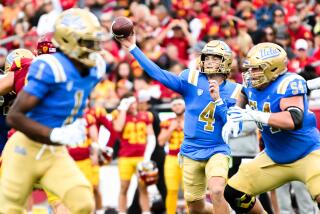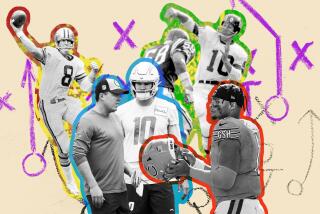Norman Sas dies at 87; inventor of quirky tabletop toy called Electric Football
Well before “Madden NFL” video games, there was a quirky tabletop toy called Electric Football.
Surely you remember it: Metal playing field. Two teams of 11 plastic football players, each standing on a rectangular base with prongs on the bottom and a knob on the side. At the beginning of each play, the human “coach” sets the players in the desired position and puts the football in the hands of one. A switch is flicked, the gridiron vibrates and the players move — often wildly in every direction. Occasionally the player with the ball “runs” to daylight.
Norman Sas invented Electric Football in 1948 and introduced it a year later. But it wasn’t until 1967, when he signed a deal with NFL Properties, the pro football league’s product licensing division, that the plastic players represented actual NFL teams and Electric Football really took off.
Sas, 87, who died June 28 at his home in Vero Beach, Fla., after a stroke, was “one of the real innovators of toy land,” said Chris Byrne, content director of timetoplaymag.com, a toy review website.
“Who would’ve thought that a vibrating metal plate could capture the imagination of so many boys?” Byrne said, adding that the “chaos and unpredictability” of the players’ movements gave Electric Football its magic.
Born in New York City in 1925, Norman Anders Sas received degrees in mechanical engineering and business administration from Massachusetts Institute of Technology before and after serving in the Navy during World War II. He became president of his father Elmer’s New York company, Tudor Metal Products, in 1948. Among its products were toy musical instruments and an item born of Depression-era thrift: a “Budget Bank” for sorting pocket change and bills.
The 23-year-old Norman wasted no time making his mark. Inspired by a vibrating horse-racing toy he’d seen, he came up with Electric Football and quickly got it to market.
“Actual football thrills for armchair strategists!” said a 1949 New York Times display ad touting the game, available for $5.95 at the A&S department store on Fulton Street in Brooklyn.
The headline blared, “‘Men’ Actually Move in New Electric Football Game!”
Electric Football’s success was such that Tudor Metal Products changed its name to Tudor Games. Other manufacturers rolled out their own versions, but it was Sas’ game that received the NFL’s imprimatur and landed in the Sears catalog. A December 1971 Sports Illustrated story identified Tudor Electric Football — then retailing for $9.95 to $14.95 — as the “bestseller” among all NFL-licensed products.
“For the first 10 years, we generated more money for NFL Properties than anyone else,” Sas said in a 1999 Washington Post story about the Electric Football phenomenon. “Then the [video] games came out, and that was the beginning of the end.”
Sas retired in 1988 after selling Tudor Games to Miggle Toys. He moved from Alpine, N.J., to Vero Beach, Fla., about 15 years ago. Survivors include his wife of 62 years, Irene; two daughters; and seven grandchildren.
As for Electric Football, it’s still chugging and vibrating in this era of video and computer playthings, and there are competitions nationwide sponsored by the Miniature Football Coaches Assn., a hobbyists group. Miggle Toys continued to make Electric Football; in February, Miggle was acquired by a Seattle toy maker, Ballpark Classics Inc. Ballpark reverted to the name of Sas’ company, Tudor Games — a nod to Electric Football’s importance to the deal.
A book about Sas and Electric Football, “The Unforgettable Buzz,” is scheduled to be published this year. One of its authors, Earl Shores, said the Electric Football game he received for Christmas in 1968 — NFL 620 model, New York Giants versus Cleveland Browns — “was the most important present I ever got.”
“You’d sit there and on the 10th try your running back would turn to the left and magically go down the field for a touchdown,” he said. “You played Electric Football for that one moment.”
Levin writes for the Record of Hackensack, N.J., and McClatchy Newspapers.
More to Read
Start your day right
Sign up for Essential California for the L.A. Times biggest news, features and recommendations in your inbox six days a week.
You may occasionally receive promotional content from the Los Angeles Times.






